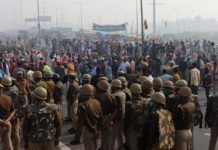
Rajasthan, known for its arid landscape and historical grandeur, recently witnessed a tragic turn of events due to unexpected heavy rainfall. The sudden deluge led to the unfortunate loss of two lives, while eight others were miraculously rescued from being swept away by strong water currents. As the state grapples with the aftermath, the incident highlights the growing concerns around weather-related disasters and the importance of preparedness.
Overview of Recent Rainfall in Rajasthan
Rajasthan, typically characterized by its dry climate, has been experiencing unusually heavy rainfall over the past few days. This has resulted in widespread flooding, particularly affecting rural and low-lying areas. The rains have caused rivers to swell beyond their capacities, leading to dangerous conditions in several parts of the state. Cities like Jaipur, Ajmer, and Jodhpur have seen significant waterlogging, while rural areas are facing the brunt of the flooding.
Rain-Related Incidents Leading to Fatalities
The recent downpour has unfortunately led to the loss of two lives in separate incidents. In one case, a man was caught off guard by the rapidly rising waters while attempting to cross a swollen river. Despite efforts to save him, the strong currents proved too powerful, resulting in his tragic death. In another incident, a woman lost her life after her vehicle was swept away by floodwaters on a submerged road. These incidents underscore the deadly potential of flash floods and the need for caution during such extreme weather conditions.
Local authorities were quick to respond, but the intensity of the rain and the speed at which the situation escalated left little room for successful intervention. The police and local rescue teams have been working tirelessly to ensure the safety of residents, but the unpredictability of the weather poses significant challenges.
Rescues Amidst Rising Water Levels
Amidst the chaos, there have been some stories of hope. Eight individuals were successfully rescued from life-threatening situations, thanks to the quick action of rescue teams. In one instance, a group of four people stranded in a rapidly flooding area was airlifted to safety by the National Disaster Response Force (NDRF). In another rescue, a family trapped on the roof of their house was saved just in time as the floodwaters continued to rise.
These rescue operations were not without challenges. The fast-moving water and treacherous conditions made it difficult for teams to reach those in need. However, their determination and coordination were crucial in ensuring that these individuals were brought to safety.
Role of the National Disaster Response Force (NDRF)
The NDRF has been at the forefront of rescue efforts in Rajasthan. Their expertise in dealing with natural disasters has been instrumental in saving lives during this crisis. Working closely with local authorities, the NDRF deployed multiple teams across the state to respond to emergency calls. Their involvement has been a lifeline for many who found themselves in perilous situations.
Eyewitness Accounts
Eyewitnesses have shared harrowing accounts of the incidents. One survivor described the terrifying moment when the water began rising rapidly, leaving little time to react. “It was like a nightmare,” said a local resident. “The water came so fast; we barely had time to get to higher ground.” Such testimonies paint a vivid picture of the panic and desperation that many felt during the height of the flooding.
Causes of the Sudden Heavy Rainfall
The sudden and intense rainfall in Rajasthan can be attributed to a combination of meteorological factors. The region is currently in the midst of the monsoon season, which typically brings heavy rains. However, this year’s monsoon has been particularly vigorous, leading to more rainfall than usual. Additionally, changes in atmospheric pressure and wind patterns have contributed to the concentration of rain over specific areas, exacerbating the situation.
Vulnerable Regions in Rajasthan
Certain regions in Rajasthan are more prone to flooding than others. Areas near rivers and low-lying regions are particularly vulnerable during heavy rains. The districts of Barmer, Jalore, and Pali have historically experienced significant flooding during the monsoon season. These regions, with their flat terrain and limited drainage systems, are often the first to be impacted when the rains come.
Government and Public Response
The Rajasthan government has been quick to respond to the crisis, deploying rescue teams and issuing warnings to residents in affected areas. Evacuations have been carried out in the most vulnerable regions, and temporary shelters have been set up to accommodate those displaced by the floods. The government has also urged people to stay indoors and avoid traveling through flooded areas.
Public response has been a mix of concern and resilience. Many residents have banded together to help those in need, offering shelter and support to those affected by the floods. Social media has played a crucial role in spreading awareness and coordinating relief efforts, with locals sharing updates and information on safe routes and rescue operations.
Emergency Measures Implemented
In response to the heavy rainfall, the government has implemented several emergency measures. These include the closure of schools and offices in affected areas, as well as the suspension of public transportation in regions where roads have been submerged. Additionally, the government has set up a helpline for those in need of assistance and has deployed medical teams to provide aid to those injured or affected by the floods.
Long-Term Impact on the Community
The long-term impact of this rainfall and flooding on the communities in Rajasthan is expected to be significant. Economically, the damage to infrastructure, homes, and agricultural land will be substantial, with many families likely to face financial difficulties as they rebuild. The psychological impact on survivors and those who lost loved ones will also be profound, with the trauma of the events likely to linger.
Restoration and Relief Efforts
Efforts to restore normalcy are already underway, with the government and various organizations working to provide relief to those affected. Relief materials, including food, water, and clothing, are being distributed to those in need. Additionally, the government has announced financial assistance for families who have lost loved ones or have had their homes damaged by the floods.
Role of NGOs and Community Groups
Non-governmental organizations (NGOs) and community groups have been playing a vital role in the relief efforts. These groups have been providing immediate assistance to those affected by the floods, including distributing food and medical supplies, as well as helping to coordinate rescue operations. Their work has been crucial in reaching areas that are difficult to access and ensuring that aid is distributed effectively.
Conclusion
The recent rain-related incidents in Rajasthan serve as a stark reminder of the power of nature and the importance of being prepared for such events. While the loss of life is tragic, the efforts of the rescue teams and the resilience of the community offer hope for the future. It is essential that the government, along with local communities, continues to work towards improving disaster preparedness and response measures to minimize the impact of such incidents in the future.
FAQs
- What were the main causes of the heavy rainfall in Rajasthan?
The heavy rainfall in Rajasthan was primarily due to the monsoon season, which brings increased rainfall to the region. Additionally, changes in atmospheric pressure and wind patterns contributed to the intensity of the rain. - How did the authorities respond to the rain-related incidents?
Authorities responded swiftly by deploying rescue teams, including the National Disaster Response Force (NDRF), to assist those affected by the floods. Evacuations were carried out in vulnerable areas, and temporary shelters were set up for displaced individuals. - What are the long-term effects of such incidents on the local community?
The long-term effects include economic damage due to the destruction of infrastructure and homes, as well as psychological trauma for survivors and those who lost loved ones. The community will also face challenges in rebuilding and recovering from the disaster. - How can residents prepare for future rain-related emergencies?
Residents can prepare by staying informed about weather forecasts, creating emergency plans, and having essential supplies ready. It is also important to heed government warnings and avoid traveling through flooded areas. - What is being done to prevent similar incidents in the future?
The government is working on improving disaster preparedness measures, including better infrastructure for flood management, increased coordination between agencies, and public awareness campaigns to ensure that residents are better prepared for future emergencies.

































